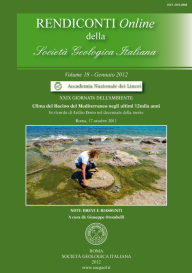
Vegetazione e clima nel Bacino mediterraneo durante l'Olocene
Donatella Magri (*)
(*) Dipartimento di Biologia Ambientale, Sapienza Università di Roma, Piazzale Aldo Moro 5, 00185 Roma. E-mail: donatella.magri@uniroma1.it
DOI: https://doi.org/10.3301/ROL.2011.62
Volume: 18/2012
Pages: 29-31
Abstract
Vegetation and climate in the Mediterranean Basin during the Holocene.
The Holocene history of the Mediterranean regions has been influenced by multiple factors, including Quaternary climate fluctuations, complex geographical and physiographical situations, and a long history of human occupations. Interactions among these factors make it often difficult to reconstruct the Holocene climate fluctuations from the vegetational changes recorded by pollen data. The modern vegetation depends not only on climatic factors, determining the distribution of vegetation in latitudinal and longitudinal belts, but also on the location of the refuge areas where temperate forests could withstand the driest phases of the last glacial period and from where they spread during the postglacial. In the Mediterranean regions, the human occupations since the Palaeolithic determined significant changes in the vegetational landscape, through clearance, agriculture, livestock breeding and fires, which often obliterate the responses of plant species to natural factors.
During the lateglacial and early Holocene (15-9 cal ka BP) the vegetation changes in relation to climate flutuations were geographically much diversified. In mountain areas, the expansion of dense mixed forest vegetation in areas previously occupied by steppe and grasslands started already around 13.7 cal ka BP (Huntley et alii, 1999; Magri, 1999), while in southern Mediterranean regions (Sicily: Sadori & Narcisi, 2001; Morocco: Rhoujjati et alii, 2010; Lebanon: Hajar et alii, 2010) the reafforestation process occurred after 11 ka BP. In spite of this regional variability, it is possible to recognise vegetational fluctuations recorded in large regions of the Mediterranean Basin. For example, around 4 ka BP a temporary reduction of the evergreen vegetation has been recorded in several pollen records of the Central Mediterranean regions south of 43°N, possibly driven by the northward progression of a north African high pressure cell (Di Rita & Magri, 2009). Since the mid-Holocene, a general increase of the evergreen elements is observed, especially in the most arid areas of the Mediterranean basin (Jahns, 1993; Jalut et alii, 2000; Sadori & Narcisi, 2001; Di Rita & Magri, 2009; Di Rita et alii, 2011).
In historical times, the demographic increase and the diffusion of human activities have certainly determined considerable changes in the vegetational landscape, so that it is very difficult to identify any climate change from the pollen records. Even so, it cannot be excluded that some recent vegetational changes may be caused by natural rather than human factors.
The discussion on timing, modes and trends in the Holocene vegetation dynamics of the Mediterranean regions is very lively and offers the intriguing possibility of multidisciplinary interpretations of complex phenomena, so contributing to the study on the ongoing climate changes and to management and conservation actions of one of the most important biodiversity hotspots in the world.
Keywords
Get Full Text